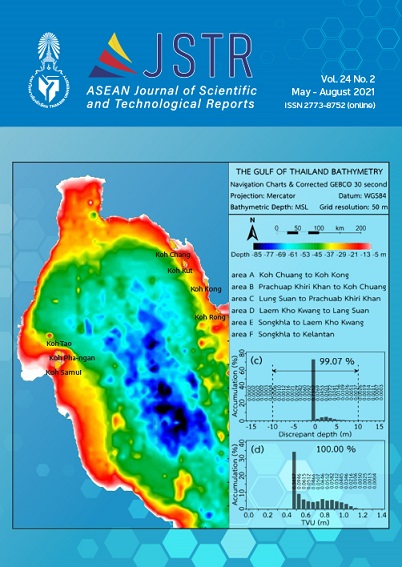Properties of Natural Rubber with Molasses Carbon Powder Activated Using Microwave Radiation as a Filler
Main Article Content
Abstract
In this research, the preparation of carbon powder from molasses, a by-product of the sugar production process or agricultural wastes, was studied as filler in natural rubber. The carbon powder from molasses or molasses black (MB) was subsequently activated using 1:4 by weight (MB: KOH) using heating energy from microwave radiation and comparing with the electrically heating furnace. The result showed the surface area and total pore volume of MB activated by microwave radiation (MB KOH Wave) are clearly enhanced comparable with those activated using an electrically heating furnace. All of KOHactivated MB were used as filler in NR in the amount of 10 phr. It was found that MB KOH Wave filled NR obviously shows the improvement in cure characteristic, tensile properties, tear strength and swelling resistance of NR vulcanizate and is close with that of filled with carbon black (CB).
Article Details

This work is licensed under a Creative Commons Attribution-NonCommercial-NoDerivatives 4.0 International License.
References
Yangthong, H., Pichaiyut, S., Jumrat, S., Wisunthorn, S., & Nakason, C. (2018). Novel natural rubber composites with geopolymer filler. Advances in Polymer Technology, 37(7), 2651–2662.
Broderick, G.A., & Radloff, W.J. (2004). Effect of molasses supplementation on the production of lactating dairy cows fed diets based on alfalfa and corn silage. Journal of Dairy Science, 87, 2997–3009.
Saowapark, T., Plao-le, S., Chaichana, E., & Jaturapiree, A. (2017). Role of eco-friendly Molasses carbon powder as a filler in natural rubber vulcanizates. Materials Today: Proceedings, 4(5), 6450–6457.
Homkeing, S., & Saowapark, T. (2017). A study on properties of nitrile rubber filled with molasses carbon filler. Thaksin University Journal, 20(3), 193–200.
Foo, K. Y., & Hameed. B. (2009). Recent developments in the preparation and regeneration of activated carbons by Microwaves. Elsevier Advances in Colloid and Interface Science, 149, 19–27.
Qin, S.L., Zheng, T., Li, N., Wang, P., & Abulikemu, G. (2010) Modification of bamboo-based activated carbon using microwave radiation and its effects on the adsorption of methylene blue. Applied Surface Science, 256, 3309–3315.
Hidayu, A. R., & Muda, N. (2016). Preparation and characterization of impregnated activated carbon from palm kernel shell and coconut shell for CO2 capture. Procedia Engineering, 148, 106–113.
Shaaban, A., Se, S. M. , Ibrahim, I. M., & Ahsan, Q. (2015). Preparation of rubber wood sawdust based activated carbon and its use as a filler of polyurethane matrix composites for microwave absorption. New Carbon Letter, 30, 167–175.
Chotitham, L., Sumanatrakul, P., & Kongsune, P. (2016). Preparation, characterization and application for lead adsorption of Dendrocalamus Asper Backer bamboo activated carbon. Thaksin University Journal, 19(2), 43–51.
Assawasangrat, P., & Juengsamarn, T. (2016). Synthesis activated carbon from coffee residue by using microwave radiation. Ladkrabang Engineering Journal, 33(1), 36–41.
Das, A., Debnath, S. C., De, D., & Basu, D. K. (2004). Evaluation of physical properties and curing characteristics of silica filled ethylene–propylene–diene terpolymer in the presence of chloroprene rubber. Journal of Applied Polymer Science, 93, 196–200.


